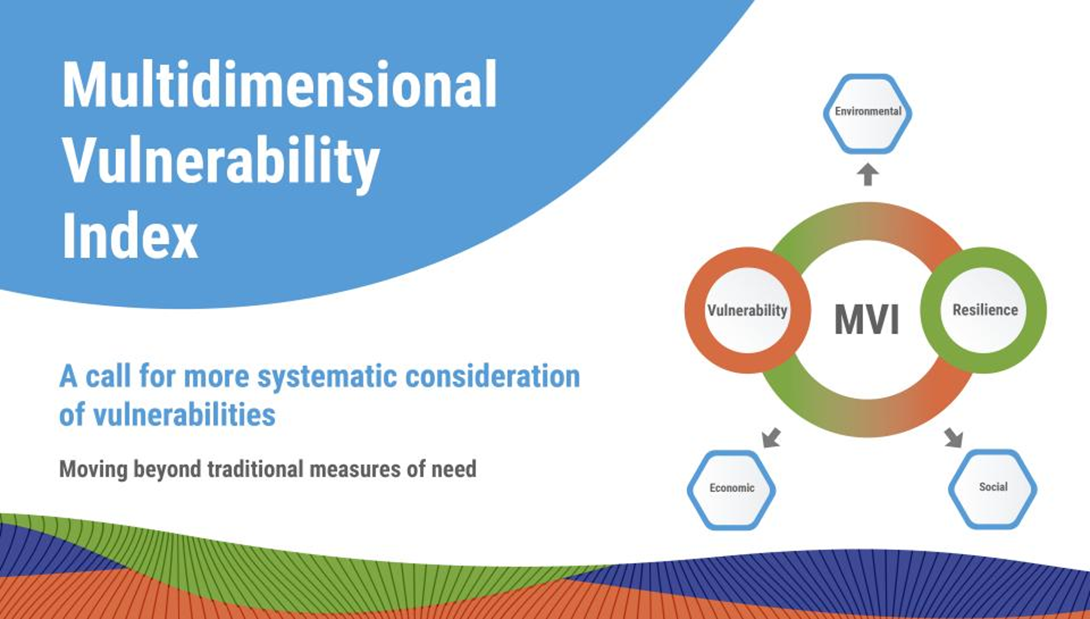- Courses
- GS Full Course 1 Year
- GS Full Course 2 Year
- GS Full Course 3 Year
- GS Full Course Till Selection
- CSAT
- 5 LAYERED ARJUNA Mentorship
- Public Administration Optional
- Online Program
- GS Recorded Course
- NCERT (Recorded 500+ Hours)
- Polity Recorded Course
- Geography Recorded Course
- Economy Recorded Course
- AMAC Recorded Course
- Modern India, Post Independence & World History
- Environment Recoded Course
- Governance Recoded Course
- Science & Tech. Recoded Course
- International Relations and Internal Security Recorded Course
- Disaster Management Module Course
- Ethics Recoded Course
- Essay Recoded Course
- Current Affairs Recoded Course
- ABOUT US
- OUR TOPPERS
- TEST SERIES
- FREE STUDY MATERIAL
- VIDEOS
- CONTACT US
Multidimensional Vulnerability Index (MVI)
Multidimensional Vulnerability Index (MVI)

The UN General Assembly recently launched the Multidimensional Vulnerability Index (MVI) to help Small Island Developing States (SIDS) to secure low-interest financing.
- Historically, SIDS have struggled to access such financing due to their relatively higher GDP per capita despite their vulnerability to external shocks like climate change.
What is Multidimensional Vulnerability Index (MVI)?
- The MVI is an international quantitative benchmark designed to measure structural vulnerability and lack of resilience across various dimensions of sustainable development at the national level.
- It serves as a complement to Gross National Income (GNI) per capita.
Need for MVI:
- Current Limitations: Traditional measures like GNI per capita fail to capture the development and well-being of countries facing high risks of external shocks.
- Access to Concessional Financing: Eligibility for affordable development support is often determined by income thresholds, not vulnerability.
- Inclusive Aid Allocation: The MVI could better guide development policies and aid allocation by providing early identification of nations in need of international assistance.
Structure of the MVI:
- Universal Level Quantitative Assessment: Provides a summary index that ranks countries based on structural vulnerability and resilience using a common methodology. This is presented as an overall MVI score.
- Vulnerability-Resilience Country Profiles (VRCP): Offers a detailed, tailored characterization of each country’s specific vulnerability and resilience factors.
Key Principles Guiding MVI Index Construction:
- Multidimensionality: Covers economic, environmental, and social dimensions of sustainable development.
- Universality: Designed to capture vulnerabilities across all developing countries for credibility and comparability.
- Exogeneity: Differentiates between policy-induced and exogenous factors to reflect structural challenges independent of government actions.
- Availability: Uses reliable, recognized, and comparable data.
- Readability: Clear and comprehensible design.
Conceptual Framework for the MVI:
The MVI is based on two main pillars:
- Structural Vulnerability: Linked to a country’s exposure to adverse external shocks and stressors.
- Structural Resilience: The capacity to withstand and recover from such shocks.
Dimensions of Sustainable Development:
- Economic Vulnerability: Risks from adverse external economic shocks.
- Environmental Vulnerability: Risks from natural hazards, climate change, and anthropogenic shocks.
- Social Vulnerability: Risks from social shocks.
Resilience Types:
- Structural Economic Resilience: Economic capabilities and capital that aid recovery.
- Structural Environmental Resilience: Environmental capital and infrastructure that reduce vulnerability.
- Structural Social Resilience: Social capabilities and human capital that enhance adaptive capacity.
Indicator Selection and Index Construction:
- Chosen indicators are of high quality and sourced from United Nations data.
- Indicators are combined into a single vulnerability metric through rescaling, aggregation, and weighting.
Key Observations by the MVI Panel
- Correlation: High structural vulnerability often correlates with low structural resilience.
- Income Independence: MVI scores are not directly related to income levels, making it a valuable complement to GNI.
- Small Island Developing States (SIDS): The MVI does not discriminate against small countries; 70% of SIDS score above the median.
- Ranking and Thresholds: Many countries are moderately vulnerable, complicating the establishment of a clear vulnerability threshold for aid allocation.
Recommended Use of MVI
- Incorporation by Donors: Donors and international financial institutions (IFIs) should explore integrating the MVI into existing policies to ensure a common approach to aid distribution.
- Debt Assessment: Use the MVI to assess external debt sustainability and the need for concessional debt restructuring, in addition to income-based assessments.
Conclusion
The Multidimensional Vulnerability Index represents a significant advancement in addressing the complex challenges faced by vulnerable countries, particularly SIDS. By offering a comprehensive assessment of vulnerability and resilience across multiple dimensions, the MVI has the potential to transform global development policies and ensure that assistance is directed more effectively. Its implementation could lead to more equitable and targeted support for countries that are most in need, ultimately contributing to more sustainable and inclusive development outcomes.




